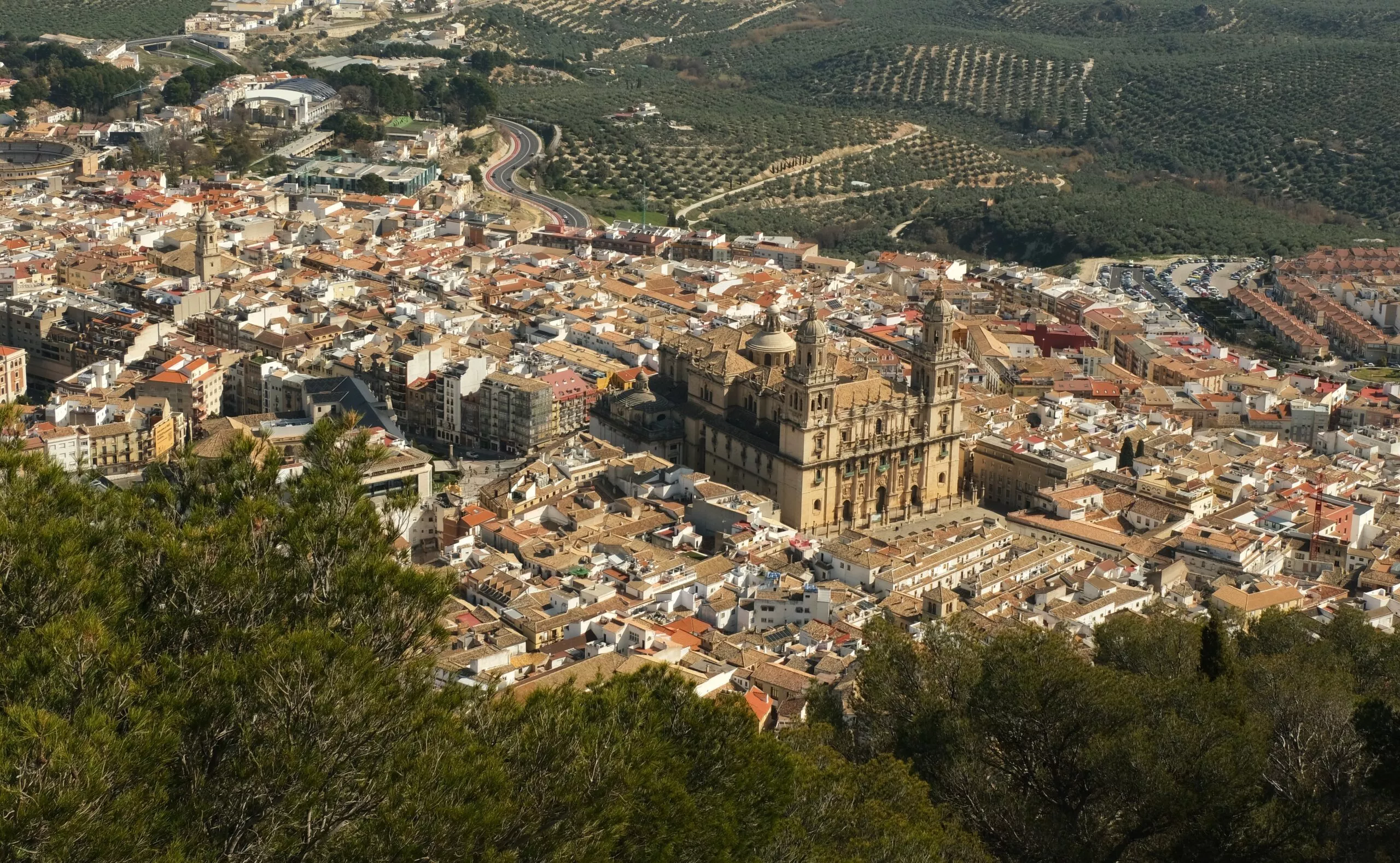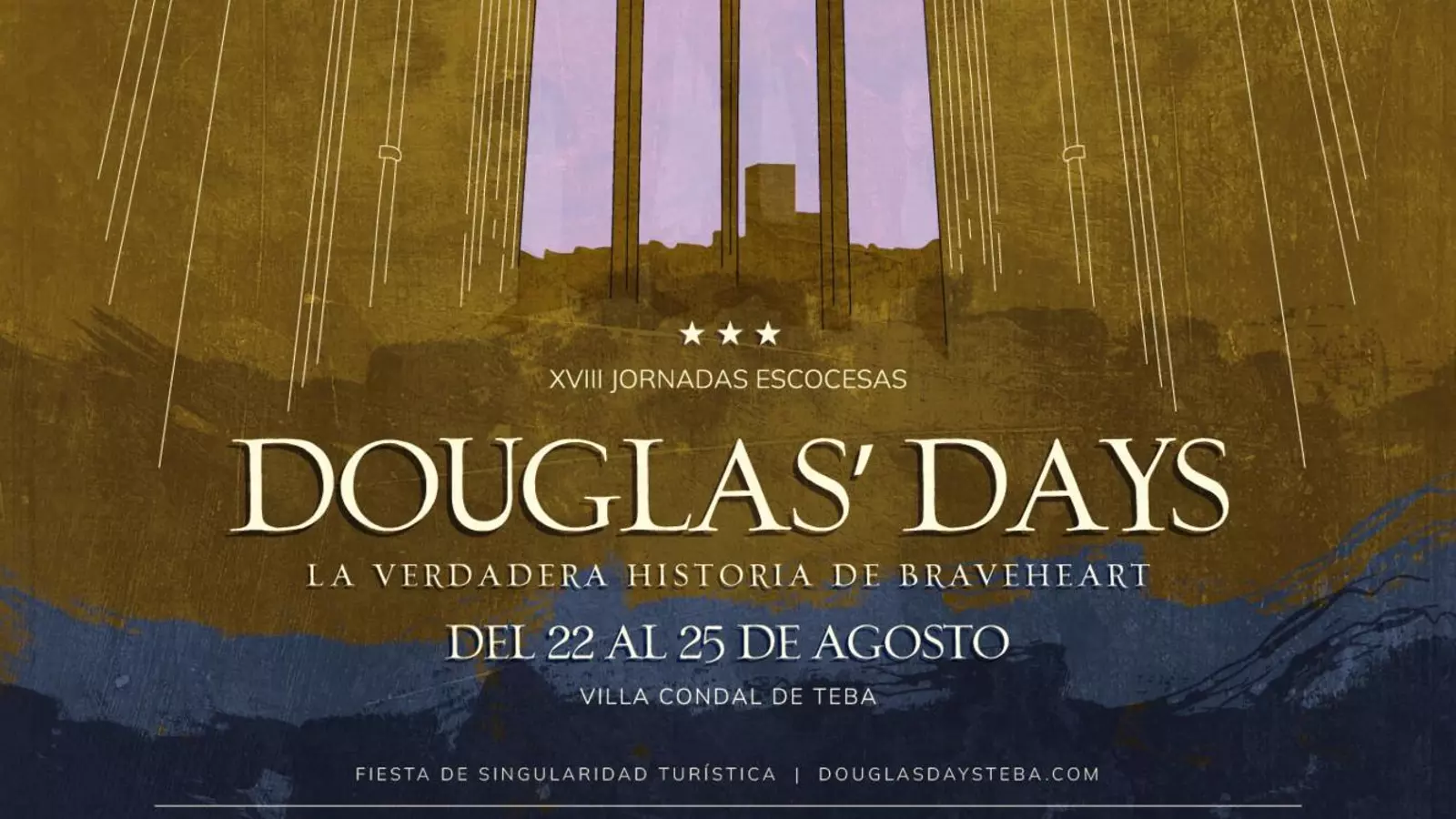Unusual Malaga – 22 places and curiosities to experience
Malaga and its unusual places to discover
In this article you’ll find a wealth of curiosities and unusual places to see in Malaga:
- A few words about this Malaga
- See the map of Malaga
- Unknown and unusual places to see in Malaga
- What to do in Malaga
- Booking accommodation
- Useful links (bookings and visits in Andalucia)
- Continuing your trip to Andalucia

A few words about Malaga de mis amores
I’ve had a special relationship with Malaga since the 1980s, since 1986 to be precise. I’ve seen it change and become the magnificent city it is today. That’s why you’ll find several photos of the city’s facades in the article.

Malaga is a city full of life and its long history offers us many curiosities and unusual places to discover. This article will hopefully complete your list of things to see in Malaga.
A trip to Malaga is a journey through history, culture, beauty and sunshine. Thanks to its climate, Malaga is a pleasant place to visit all year round. There are also several very festive periods in Malaga, during Holy Week, during the famous Malaga Fair and at the end of the year, from Christmas until the Cabalgata de Reyes Magos, on 5 January.

See the map of Malaga
Below is a map of the historic centre of Malaga. By zooming in, the different monuments appear to make it easier to find your way around.
Unusual sights and places to see in Malaga
Here are the unusual places and sights we’re going to see in Málaga:
- 1 – Atazanaras, the old shipyard
- 2 – The curious privilege of the Brotherhood of Jesús El Rico
- 3 – The curious procession of the Holy Christ of the Good Death
- 4 – Biznaga de Oro
- 5 – Discover 2 funerary mosques (unique in the world)
- 6 – The house of inculture
- 7 – The Bridge of the Germans
- 8 – The Madwomen of Málaga
- 9 – La Manquita – the Manchot –
- 10 – The English minute of the Malaga metro
- 11 – In the footsteps of Al-Andalus
- 12 – Vocabulary for ordering a coffee in Malaga
- 13 – The English cemetery
- 14 – 4 July, American Independence Day
- 15 – H.C. Andersen as in a fairy tale
- 16 – Nuestra Señora de la Victoria basilica
- 17 – A female lighthouse
- 18 – The oldest tavern in Malaga
- 19 – El Pimpi, the first disco
- 20 – The sights of Calle Larios
- 21 – The painted façades
- 22 – Urban art in Málaga – street art –

Atazanaras, the old shipyard
The famous Atazanaras covered market is well known, but little is known about the origins of this site.

Atazanaras was originally the shipyard of the Nasrid kingdom of Granada. In fact, at the time, the sea bordered the Atazanaras shipyard, making it easy to launch ships.

Note: Throughout its history, Málaga has undergone several periods of major construction work that have taken the city further out to sea.
The curious privilege of the brotherhood of ‘Jesús el Rico
This brotherhood enjoys a curious privilege during Holy Week.
In 1759, King Carlos III granted this brotherhood the privilege of freeing a prisoner.

The king created this law to thank the prisoners who took part in processions during the plague of the 18th century.
Another version says it followed a revolt by prisoners who were not allowed to ask for divine intercession to end the plague.
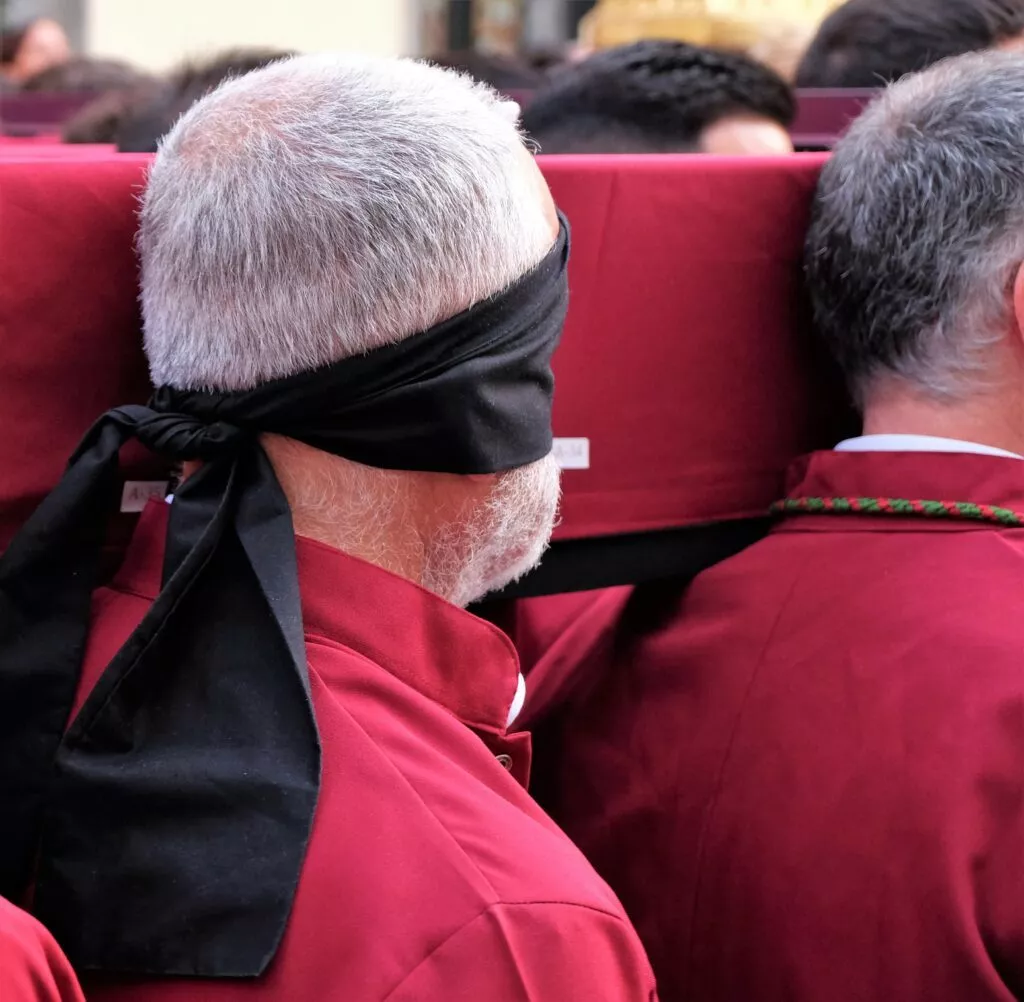
Anecdotes in the 265 years that this law has existed
- no release of prisoners during the civil war from 1936 to 1939
- 2017: refusal by the Council of Ministers due to the seriousness of the crimes committed by the prisoner
- 2020: covid – no release
- 2021: release of 3 prisoners by the brotherhood of Jesús el Rico
The procession of the Holy Christ of the Good Death
This procession is a special one, as the Holy Christ of the Good Death is the patron saint and protector of the Spanish Legion.
The canonical seat of the Congregation of Mena is in the Santo Domingo church in the centre of Málaga.

It is known as the Congregation of Mena, but its official name is the Pontificia y Real Congregación del Santísimo Cristo de la Buena Muerte y Ánimas y Nuestra Señora de la Soledad Coronada.
Here is a video of this famous procession which takes place on Maundy Thursday:
Biznaga de Oro
The Malaga Spanish Film Festival is the most important event in the Spanish film industry. The prize awarded is the ‘Biznaga de oro‘, named after the city’s emblematic ‘flower’.

Biznaga de Oro can be seen on the façade of the famous Albeniz cinema, near the Roman Theatre.

Discover 2 funerary mosques (unique in the world)
This is a truly extraordinary site in Malaga. It consists of 2 funerary mosques, one next to the other, dating from the Almohad period (12th and 12th centuries) and located not far from the necropolis of Yabal Faruh. The site also features a mausoleum from the Nasrid period. On the mausoleum, several decorations such as the 7-pointed cross and a tree of life (partial) are clearly visible.

Visits are by appointment only from the Junta de Andalucía website. This site was discovered in the early 1990s during the construction of the building under which it is located. It has been open to the public since April 2023, and the visit is led by the archaeologist in charge of the site.

NB: these two small funerary mosques remain a mystery to this day, since in Islam a mosque can only be a place of worship. And another curiosity: two other funerary mosques have been found in the world….they are also in Malaga and are not, or not yet, open to the public.
Unusual Malaga – The house of inculture
I have to tell you straight away that you won’t be seeing this house! It doesn’t exist. It is, however, the old nickname given by the malagueños to a building in the city.
The story is quite funny:
Seventy years ago, in 1951, the city council decided to create a garden around this building, the House of Culture, located at the foot of the Alcazaba.
While preparing this space, archaeological remains were discovered. Excavations revealed a large Roman theatre, the same one we know today. The Andalucia people, always quick to give nicknames, nicknamed this building, which was later destroyed, the Casa de la Incultura…
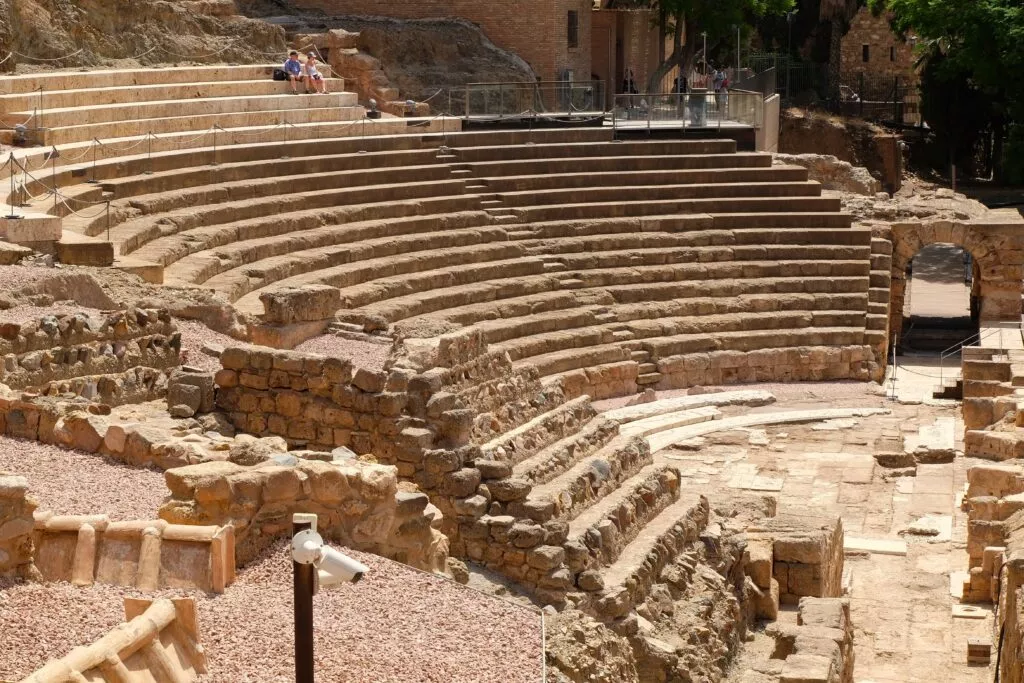
A more recent anecdote: a world-famous film star made his acting debut in this theatre in the 1970s. A young football player was injured during a match and had to give up the sport. His name was Antonio Banderas and he decided to join a local theatre company.
The plays performed by this troupe were systematically censored by Franco’s regime. The troupe’s plays were therefore performed underground, in this theatre.

Bridge of the Germans
This bridge is linked to a dramatic incident in December 1900. A German ship, the Gneisenau, was caught in a heavy storm as it entered the port.
Many Malaga residents came to the aid of the German sailors. The storm claimed the lives of 53 sailors and residents.

The rest of the story….
A month later, in January 1901, the regent Maria Cristina granted Malaga the title of Muy Hospitalaria by decree. This can be seen on the city’s coat of arms.
Six years later, in 1907, Malaga suffered a major flood, destroying most of the bridges over the River Guadalmedina. Several Germans living in Malaga launched the idea of collecting donations in Germany to rebuild a bridge.
The collection was a complete success in Germany, which remembered what the Malagueños had done to save sailors.

On 16 December 1909, 9 years to the day after the sinking of the German ship, the bridge was inaugurated. The official name is the Puente Santo Domingo, but it is also known as the Puente de los Alemanes.
The madwomen of Málaga
Loca (crazy, fool, mad girl) is the name of a pastry that originated in the Tejeros bakery. It is one of the typical local dishes, like espeto de sardinas or ajoblanco.
In the post-war period of the 1950s, poverty and hunger were part of everyday life, and these fairly basic pastries, known as locas, acted as sweet quitahambres – appetite suppressants.
Two stories dispute the origin of the loca’s name:
- it was made in a bakery opposite a former women’s psychiatric hospital.
- Another version says that its first name was Loco, and that the idea came from listening to the song by Luisa Linares y los Galindos, which goes: “a lo loco se vive mejor” (mads live better).
La Manquita – the Manchot – is the nickname given to the local people.
La Manquita is the nickname given to Málaga Cathedral, whose real name is Santa Iglesia Catedral Basílica de la Encarnación.

This cathedral, commissioned by the Catholic Monarchs in 1528, has still not been completed. It probably never will be.
This cathedral, built on the site of Malaga’s former great mosque, has had a chequered history, with funding problems from the outset. Construction began in the 15th century and took around 250 years.
It was not until 1719 that one of the towers and the main façade were completed.
It is said that in the 18th century, construction of the South Tower was halted and the funds intended for the cathedral were used to support the United States in the War of Independence. Today, 500 years later, the Cathedral is still missing several elements, including the famous South Tower.
Note: on one of the walls of the cathedral, there is a plaque commemorating the Americans with the words “gratitude for the economic aid given”. However, there is no evidence to support this story, despite the plaque on the wall.

It owes its popular name of “La Manquita” to the fact that the south tower was left unfinished. This detail makes it so unique that Malagueños prefer to keep it that way, as it has become a symbol of Malaga.
The English minute of the Malaga metro
The Malaga metro is different from other metros on the peninsula.
It works the “English” way. The seconds hand never marks 60 seconds, but 59. The seconds hand remains suspended until the minutes hand marks the missing second. This peculiarity comes from the old British railway clocks!
In the footsteps of Al-Andalus
In addition to the monuments we already know, there are several places in Malaga with vestiges of the Al-Andalus period. These remains date from the Muslim period of the 11th, 12th and 14th centuries.)
Here are some of the most unusual places in Malaga where you can find these remains:
Proteo bookshop
In Calle Buenaventura, on the front of the bookshop you will see the remains of the Buenaventura tower of the old Arab wall.

You can go inside the bookshop to see even more 🙂 .
MIMA (Malaga Interactive Music Museum)
If you go down to the basement of the museum on Calle beatas 15, you’ll find part of the Arab (and Roman) wall from the 3rd century AD.
Alcazaba Tunnel
On the edge of the motorway that passes through the Alcazaba tunnel you will also find some remains. The remains are on the side of the Alcazaba.
15 Alcazabilla Street
At 15 Alcazabilla Street, under a restaurant, there are the remains in very good condition of a tower, apparently called the Torre de Granada. Among the remains, there is also a room of this tower, but today it is not open to the public.
Plaza de la Marina car park, one of Malaga’s most unusual and curious spots
Inside this car park, right in the centre of Malaga, between the port and Calle Larios, you’ll also find some very interesting remains.
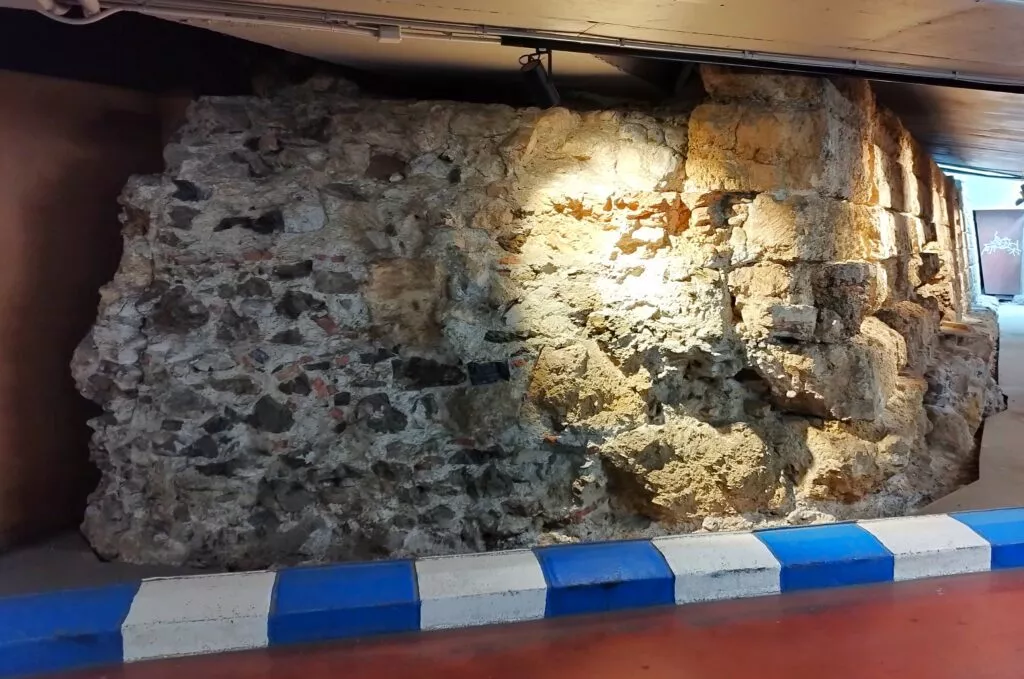
These ruins were discovered by chance when the car park was built in the 1980s.
There are some ruins of the Castillo de los Genoveses. This Genoese castle, built in the Nasrid period, faced the sea and served as a defensive wall against possible attacks from the sea. The walls of the Castillo de los Genoveses joined the city’s defensive walls, as far as the Alcazaba.

The castle was also a trading post between the Nasrid kingdom and the merchants from Genoa, with whom a trade agreement had been signed.

Cafeteria of the Hotel Tribuna
The hotel is located at calle Carretería 6. The remains are located in the basement of the cafeteria, and you’ll have no trouble seeing them here either. What’s interesting is the remains of the wall and also of the barbican (the outer wall protecting the wall).
Vocabulary for ordering a coffee in Malaga
Here’s a quick but essential introduction for coffee drinkers in Malaga. Please note that by default, coffee is served with milk in Malaga.
Here then, is the basic vocabulary for a good stay in Malaga 🙂 .

The English Cemetery
This cemetery in the centre of Malaga, on the site known as the Cañada de los Ingleses, was built in 1821. The English Cemetery was the first Protestant cemetery in Spain.
The curiosity of this Malaga cemetery lies in the old British legend surrounding it, according to which the last person to be buried in a cemetery becomes its guardian.
4 July, United States Independence Day
Every year, Malaga commemorates the Independence of the United States of America. This celebration takes place in two places, in the Plaza del Obispo – or Bishop’s Square for the occasion :)) :

Then on to Macharaviaya, a small village close to where Bernardo de Galvez was born. In the village, the Battle of Pensacola is re-enacted as part of the celebrations.
This Spanish soldier, Bernardo de Galvez, fought a decisive battle in Pensacola (Florida) to help the Americans win their independence from the English.

A few anecdotes linked to the Galvez family and the United States:
- in Texas, a town bears the name of Galveston, founded by a Galvez
- Pensacola is twinned with Macharaviaya
- G. Washington had promised, in 1783, to have a portrait of Bernardo de Galvez hung in the capitol. After a few years’ delay, it was hung in 2014!
- In the centre of Malaga, there is a luxury hotel, the Solesio, named after the Italian Felix Solesio, to whom Don José Gálvez y Gallardo – Secretary of the Council of the Indies – had given the exclusive right to sell decks of cards in the Americas! The royal card game factory was in the village of Macharaviaya…
H.C. Andersen as in a fairy tale
The famous Danish storyteller, of whom we have all read at least a few lines, fell in love with Malaga. In fact, he wrote a book called “Journey to Spain” during his stay in Malaga.
Today, next to the entrance to Calle Larios, there is a statue in his honour.

At the foot of the statue, we can read a sentence from Hans Christian Andersen: In no other Spanish city have I managed to feel happy and satisfied as in Malaga.
Our Lady of Victory basilica-church – Unusual Malaga
This church is completely linked to the history of Malaga and the end of the Al-Andalus period.
The church-sanctuary of Our Lady of Victory occupies the very spot that served as a camp for the troops of the Catholic Kings during the conquest of Malaga in 1487. It was the exact location used by the troops of Ferdinand of Aragon. Isabella the Catholic’s troops camped in what is now the Trinidad district.
NB: The Virgen de la Victoria also became the city’s patron saint.

Following damage over time, the church was extensively restored at the end of the 1700s.
This church in Malaga houses two baroque hidden gems which are otherwise quite unusual.
- The crypt of the Counts of Buenavista is most surprising.
NB: this amazing crypt was closed for many years, and was reopened at the end of November 2024.
- The Dome of the Chapel of the Virgin of Victory – Cúpula del camarín de la Virgen de la Victoria – which dates from the 17th century. I have rarely seen such a richly decorated dome.

Those who love Baroque will be served, and it is truly stunning. I would like to take this opportunity to thank my friend Solo Malaga, with whom I discovered many things in Malaga.

Finally, this chapel allows you to have a very surprising perspective. Indeed, this chapel is located behind the altar, and high up in the middle of the altarpiece.

So much so that when you visit this chapel, those who stayed below see you as if you were part of the altarpiece.
A feminine lighthouse
The Malaga lighthouse is called not el faro but la farola. It is the only female lighthouse in the entire Iberian Peninsula. And it is the only one in Spain with Farola del Mar in Tenerife.
This lighthouse, built in 1817, owes its name to the wife of the mayor at the time. She thought the base of the lighthouse looked like a sort of petticoat.
La Farola was declared an Asset of Cultural Interest in July 2023.
Note: Farola was completely destroyed in 1939 during a bombing. It was completely rebuilt.
The oldest tavern in Malaga
La antigua Casa de Guardia is the oldest tavern in Malaga. It opened its doors in 1840.
Even today, glasses of wine are served directly from the barrel:
Here is its exact location.
El Pimpi
The El Pimpi bar restaurant is one of the most iconic places in Malaga.

Many celebrities also go there, and even leave dedications on the numerous wine barrels. However, legend has it that the beginnings were complicated.
Everything would have improved after Gloria Fuertes came by one evening and recited some poems!

This place – built on an ancient Roman road – has had many lives:
- it was first a convent.
- then a stable
- it then became a village hall
- and finally the famous restaurant that we all know

The meaning of the name: El Pimpi
This name comes from a time when young people worked at the port. The Pimpi is the one who helped and provided some services to the sailors and travelers who landed in Malaga.
The pimpi is one of the itinerant workers of the time like the cenachero (itinerant fish seller) and the biznaguero (itinerant biznaga flower seller).

Curiosities of Calle Larios
Calle Larios – precisely Marques de Larios street – is the most famous street in Malaga. It has to be right in the center, it has to connect the city to the port and it has to be incredibly beautiful.

This street was inaugurated in 1891 and is linked to two family names:
- the Larios family, the main promoters, who acquired 90% of the street from the project.
- the Strachan family, with Eduardo Strachan the designer of this incredible street
Architecture and aesthetics of Calle Larios
- Designer Eduardo Strachan is inspired by what is new at the time in the West. He found inspiration in the new buildings of Chicago with their famous curved angles.
- Historians consider Calle Larios to be the most elegant street of the 19th century.

- it is an architectural revolution at the time which will give its identity and a unique aesthetic to Calle Larios. On the practical side, the idea is welcomed because it will allow the sea breeze to clean the surrounding streets of bad odors. Sanitation did not exist at the time.
- Strachan achieved a little stroke of architectural genius: he fixed a vanishing point at the end of the street where all the lines of the cornices and balconies of the street coincide!

The luxury of Calle Larios
- A luxurious revolution: Larios Street will be equipped with sewers and a sanitation network.
- The accommodations on Larios Street will be equipped with the ultimate luxury, i.e. running water and two bathrooms
- Calle Larios nicknamed the Ballroom by the residents of the neighboring streets: in its original construction the sidewalks of Calle Larios were made of wood, like parquet. And, in order not to damage it, domestic animals were even prohibited from passing through.

Three anecdotes:
The Bourgeoisie still remembers the day of the inauguration in 1891. The bourgeoisie who paraded on floats began, as is still customary today, to throw peladillas (sweets) to spectators on the sidewalks. That year, Malaga continued its economic decline accompanied by high unemployment and therefore tensions on the part of the people.
The local newspaper will make its front page of this inauguration day which has become a scandal, recounting how the spectators upset at receiving the peladillas began to pick them up and throw them on the floats…
The parquet sidewalks did not last long…the floods of the early 1900s destroyed them.
Calle Larios has been listed in the Guinness Book of Records since one day in 2018. In fact, 3,920 people gathered that day to dance flamenco at the same time on this street.
Painted facades
For some years now, paintings have been popping up on the façades of houses and buildings built in the 17th and 18th centuries. The frescoes, painted in the 18th century, are mostly in the form of columns or pilasters, but there are also floral and animal motifs.

The curious side of the thing is that these restored paintings are in fact very old. There are even many that remain hidden.
Indeed, in the 19th century, it was advised and requested to whitewash the walls with lime to fight against epidemics, and these murals and the splendor of yesteryear fell into oblivion.

For a long time we continued to add layers of lime.
Malaga then experienced a long period of lethargy and these facades became blackened and then decrepit.

And, it was during the 1980s (it’s not that old) that pieces of these layers of lime began to fall… revealing paintings behind!
Urban art in Malaga – street art –
Urban art – street art – is visible in many places in Malaga. However, two districts are particularly famous. There is the historic district of Lagunillas. The street art movement was born as a result of a mobilization of residents of the neighborhood which had been abandoned, to highlight it.

The second district is the Soho district. Many works can be found in the streets located between the museum of modern art and the theater recently opened by Antonio Banderas.

Here is a link to find out more and discover 40 works of street art in Malaga.
Note : in the following link you can book online several guided tours of Malaga in English.
What activities to do in Malaga and the surrounding area?
Below, here are many ideas for activities and visits classified by theme. You can reserve them online today.
The +: the activities can all be canceled up to 24 hours before the scheduled date:
Book accommodation in Malaga
Below you will find all the hotels and accommodation available in Malaga, after selecting your dates:
Some useful links for your trip to Andalusia
Easy and economical bookings
Continue your trip to Andalucia
Seville
Seville, the capital of Andalucia, is a city full of treasures to discover and monuments to visit.

Here you will find everything you can see in Seville in 3 days. And for those who will stay longer you will also find information on secret Seville and the Santa Cruz and Triana districts.
Note you can also choose to discover unusual places as well as the secrets and curiosities of Seville.
Cadiz

Visit Cadiz, a city with an incredible past and great beauty, on the Costa del la Luz.
Granada
Visit Granada, discover the Albaicin and Sacromonte districts:

Cordoba
And of course, visit Cordoba, the caliphate city, and the Juderia district.

Discover more of Andalusia’s beautiful sites in the Andalusia blog pages.
Here is the link to receive our blog newsletter.



